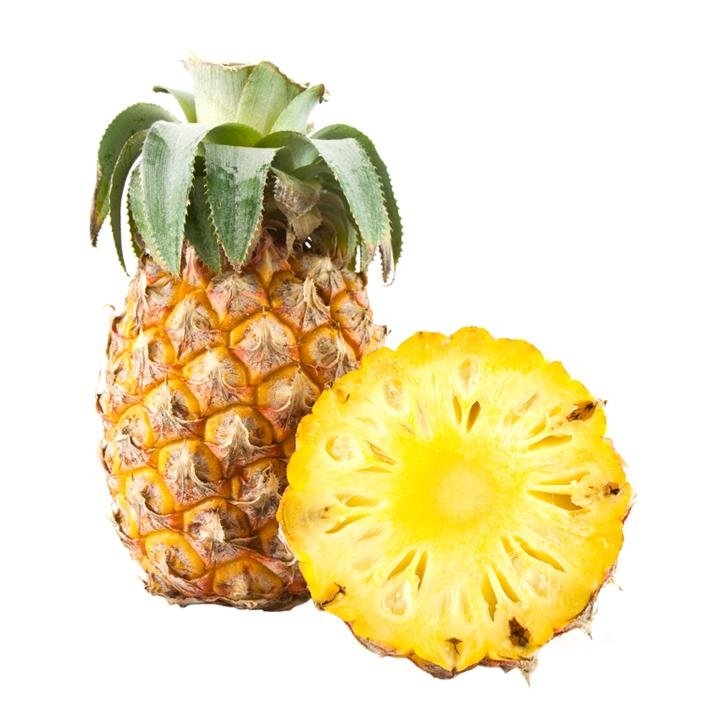The fruit comes to be a raceme-like inflorescence with each of the fruit or fruitlets originated from the development of a whole trimerous flower, located at the axil of a bract and provided by three fleshy sepals, three petals and six stamens displaced in two different sets, and a pistil with a tricarpelar ovary and three stigmas. The skin is formed by the connection of the bracts, sepals and the tissue of ovaries that produce fruitlets. The edible part of the fruit is the succulent pulp, composed by the walls of the fruitlets bracts and by the parenchymatose tissue that connects them with the external side of the skin and the core. It belongs to the Bromeliaceae family.
It is original from South America, particularly from Brazil. However, nowadays it is cultivated in many warm weather countries. Commercial pineapple (Ananas comosus) is original of tropical and sub-tropical South Africa. Its natural season is winter in the northern hemisphere, which comes to be the summer in the southern hemisphere, where most part of the pineapple production is made. The maturation of the first harvest takes place between the 18 and 24 months following the plantation. The pineapple It will not ripen once harvested. If it is harvested before ripen in order to facilitate its transportation, the result will be an acid and poor in nutrients fruit.
Fruits and stems are used (stems have a higher concentration of bromelain).
External use
- Plantas Medicinales. Margarita Fernandez y Ana Nieto. Ed Universidad de Navarra. EUNSA 1982.
- Matière Médicale. RR Paris- H. Moyse. Masson 1981.
- Guía de Campo de las Flores de Europa. Oleg Polunin. Ediciones Omega S.A. Barcelona, 1977.
- Guía de las Plantas Medicinales. Paul Schauenberg y Ferdinand Paris. Ediciones Omega S.A.
- El gran libro de las Plantas Medicinales. Editorial Everest. S.A.
- Plantes Médicinales des Régions Tempérées. L. Bézanger-Beauquene, Pinkas, Torck, Trotin.
- Plantas Medicinales. Thérapeutique-Toxicité. Christiane Vigneau. Masson, Paris 1985.
- Fitoterapia: Vademecum de Prescripción. Plantas Medicinales. Colaboran: Asociación española de médicos naturistas. Colegio Oficial de Farmacéuticos de Vizcaya.
- Pharmacognosy, Phytochemistry, Medicinal Plants. Jean Bruneton. Lavoisier Publishing.
- Plantas Medicinales. El Dioscórides Renovado. Pio Font Quer.
- Pharmacopée Française IX Édition.
- Farmacognosia 2ª Edición. Jean Bruneton. Ediciones Acribia S.A. 2001.
- Bulletin officiel Nº 90/22 bis. Ministère des Affaires Sociales et de la Solidarité.
- French Public Health Code.
- Bross B. Plantas y sus aceites esenciales. Ed. Omega, 1994.
- Martindale. The extra Pharmacopoeia 29th Edition. The Pharmaceutical Press 1989.
- The Complete German Commission E Monographs. Therapeutic Guide To Herbal Medicines. Mark Blumenthal. American Botanical Council 1998.
- Pharmacognosy, Phytochemistry, Medicinal Plants. Jean Bruneton. Lavoisier Publishing.
- Database Management Unit of the National Germplasm Resources Laboratory, Plant Sciences Institute (PSI), Beltsville Agricultural Research Center, Agricultural Research Service, U.S. Department of Agriculture.
- Samuelsson, G. Drugs of Natural Origin. A Textbook of Pharmacognosy. Stockholm: Swedish Pharmaceutical Press, 1992.
